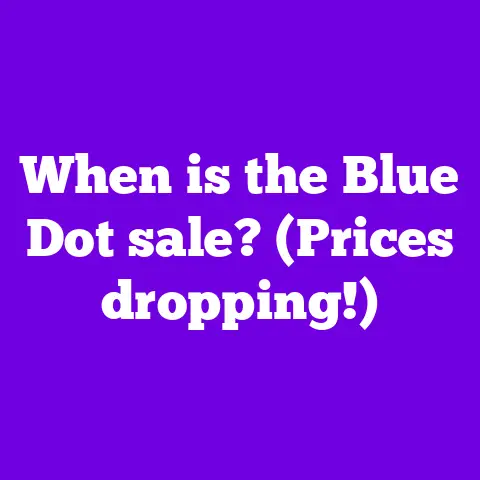When Are Winter Clothes on sale? (Before They’re Gone!)
Winter is coming.
And so is the opportunity to snag incredible deals on winter clothing!
But just like any smart investment, timing is everything.
I’m here to guide you through the ins and outs of buying winter clothes in 2025, treating each purchase not just as a necessity, but as a strategic investment in your comfort, style, and long-term savings.
Think of it like playing the stock market, but instead of stocks, we’re talking parkas and boots!
In this article, I’ll delve into the best times to buy, how to spot the best deals, and even how to make sustainable choices that benefit both your wallet and the planet.
So, buckle up, and let’s get ready to conquer the winter wardrobe market!
Understanding the Winter Clothing Market
The winter clothing market is a dynamic beast, influenced by everything from fashion trends to global economic factors.
To make informed purchasing decisions, it’s essential to understand the landscape.
The seasonal nature of the market is obvious – demand peaks in the fall and winter, leading to higher prices.
But fashion cycles also play a crucial role.
What’s “in” this year might be heavily discounted next year.
This is where understanding trends can work to your advantage.
If you’re not overly concerned with being on the cutting edge of fashion, you can often find classic styles at significantly reduced prices during off-season sales.
Key players in the industry range from major brands like Canada Goose, Patagonia, and The North Face, to large retailers like Macy’s, Nordstrom, and Amazon.
Each operates with different pricing strategies.
For example, luxury brands rarely offer deep discounts, focusing instead on maintaining brand prestige.
Meanwhile, retailers often use sales and promotions to clear out inventory and attract customers.
Online platforms like Amazon and ASOS offer vast selections and competitive pricing, but it’s crucial to be aware of potential counterfeit products and varying quality standards.
Economic factors also exert a considerable influence.
Supply chain disruptions, inflation, and fluctuations in consumer demand all impact prices.
For instance, the COVID-19 pandemic exposed vulnerabilities in global supply chains, leading to increased prices and limited availability of certain items.
According to the U.S.
Bureau of Labor Statistics, the Consumer Price Index for apparel increased by 4.2% in 2022, reflecting these economic pressures.
I expect similar, though potentially less dramatic, influences in 2025.
Key Sales Periods for Winter Clothes in 2025
Knowing when to strike is half the battle.
Here’s a detailed timeline of key sales periods you should have on your radar for 2025.
- Pre-Season Sales (Late Summer/Early Fall): Many retailers offer early bird discounts in August and September to entice shoppers before the peak season rush.
This is an excellent opportunity to snag basics like sweaters, thermals, and lighter jackets at discounted prices.
Keep an eye out for back-to-school sales that often include winter apparel. - Black Friday and Cyber Monday (Late November): These are arguably the biggest sales events of the year.
Retailers offer massive discounts across a wide range of products, including winter clothing.
Black Friday typically falls on the Friday after Thanksgiving (November 28, 2025), while Cyber Monday follows on the subsequent Monday (December 1, 2025).
Be prepared for intense competition and limited stock. - Post-Christmas Clearance Sales (Late December): After the holiday season, retailers are eager to clear out unsold inventory to make room for new spring arrivals.
This is a prime time to find deep discounts on winter coats, boots, and accessories.
Look for sales starting as early as December 26th. - End-of-Season Sales (January/February): As winter winds down, retailers slash prices even further to get rid of remaining winter stock.
This is the absolute best time to find the deepest discounts, often up to 70% or more.
However, selection may be limited, so you might have to compromise on style or color.
Notable Retail Events:
While specific dates may vary, keep an eye out for promotional events tied to Fashion Week (typically held in February and September) and other industry-specific events.
These events often inspire retailers to offer special discounts or promotions to capitalize on increased consumer interest in fashion.
How Retailers Adjust Prices:
Retailers use sophisticated algorithms and data analysis to adjust prices based on inventory levels, consumer demand, and competitor pricing.
They also employ tactics like dynamic pricing, where prices fluctuate in real-time based on factors like website traffic and user behavior.
Understanding these strategies can help you anticipate price drops and time your purchases accordingly.
Identifying the Best Deals: Strategies for Savvy Shoppers
Finding the best deals requires a strategic approach.
Think of it as developing an investment portfolio for your winter wardrobe.
- Setting a Budget and Creating a Shopping Plan: Before you even start browsing, determine how much you’re willing to spend and what specific items you need.
This will help you avoid impulse purchases and stay within your financial limits.
I like to create a spreadsheet listing the items I need, my ideal price range, and the retailers I plan to check. - Utilizing Price Tracking Tools and Apps: Several price tracking tools and apps can help you monitor price fluctuations and receive alerts when prices drop on specific items.
CamelCamelCamel (for Amazon) and Honey are popular options.
These tools can save you time and effort by automatically tracking prices and notifying you of deals. - Following Brands and Retailers on Social Media: Many brands and retailers offer exclusive deals and promotions to their social media followers.
Follow your favorite brands on platforms like Facebook, Instagram, and Twitter to stay informed about upcoming sales and discounts. - Understanding the Psychology of Sales and Discount Marketing: Retailers use a variety of psychological tactics to encourage purchases, such as creating a sense of urgency with limited-time offers or using “loss aversion” to highlight potential savings.
By understanding these tactics, you can avoid being manipulated and make more rational purchasing decisions.
Quality Over Quantity:
Remember, the goal isn’t just to buy cheap winter clothes; it’s to invest in durable, high-quality items that will last for years.
A well-made wool coat, for example, may cost more upfront, but it will provide superior warmth and durability compared to a cheap synthetic alternative.
Consider factors like material, construction, and brand reputation when evaluating quality.
The Role of Online Shopping and Technology
E-commerce has revolutionized the way we shop for winter clothing.
The convenience, wider selection, and comparative shopping tools offered by online retailers have made it easier than ever to find the best deals.
The COVID-19 pandemic accelerated the shift towards online shopping, and I expect this trend to continue in 2025.
Online retailers offer several advantages, including:
- Convenience: Shop from the comfort of your own home, 24/7.
- Wider Selection: Access a vast array of brands, styles, and sizes that may not be available in local stores.
- Comparative Shopping Tools: Easily compare prices and features across different retailers.
- Customer Reviews: Read reviews from other customers to get insights into product quality and fit.
Emerging Technologies:
AI and machine learning are increasingly being used to personalize shopping experiences and predict sales trends.
Retailers use these technologies to analyze customer data and offer targeted discounts and recommendations.
I’ve even seen AI-powered tools that can help you find the perfect winter coat based on your body type and climate.
Sustainability and Ethical Considerations in Winter Clothing Purchases
Sustainability is no longer just a buzzword; it’s a growing concern for consumers and a critical factor to consider when buying winter clothing.
Investing in sustainable and ethically produced winter wear is not only good for the environment but can also save you money in the long run.
Fast fashion has a significant environmental impact, contributing to pollution, waste, and resource depletion.
By choosing sustainable alternatives, you can reduce your carbon footprint and support brands that prioritize ethical labor practices.
Sustainable Investments:
Look for brands that use recycled materials, organic cotton, and other eco-friendly fabrics.
Patagonia, for example, is known for its commitment to sustainability and offers a wide range of winter clothing made from recycled materials.
Consider investing in timeless styles that you can wear for years to come, rather than chasing fleeting trends.
Case Studies: Successful Winter Clothing Investments
Let’s look at some real-world examples of how savvy shoppers have successfully navigated the winter clothing market.
Case Study 1: The Clearance Coat Connoisseur
Sarah, a college student, needed a new winter coat but was on a tight budget.
She waited until the end-of-season sales in February and found a high-quality wool coat at 70% off.
“I was patient and waited for the right moment,” she said.
“I ended up getting a coat that would have cost me $300 for only $90!”
Case Study 2: The Black Friday Boot Bandit
Mark, a working professional, had been eyeing a pair of durable winter boots for months.
He added them to his Amazon wishlist and tracked the price using CamelCamelCamel.
On Black Friday, the price dropped by 40%, and he immediately snagged them.
“I saved over $80 by being prepared and using price tracking tools,” he said.
Conclusion
Purchasing winter clothing doesn’t have to be a dreaded expense.
By treating it as a strategic investment, understanding market dynamics, and employing savvy shopping strategies, you can build a winter wardrobe that keeps you warm, stylish, and financially secure.
Remember, timing is crucial.
Keep an eye on key sales periods, utilize price tracking tools, and follow your favorite brands on social media to stay informed about upcoming deals.
Don’t be afraid to shop online and take advantage of the convenience and wider selection offered by e-commerce retailers.
And most importantly, prioritize quality over quantity and consider the sustainability and ethical implications of your purchases.
Start planning your winter wardrobe investments for 2025 today!
With a little preparation and strategic thinking, you can conquer the winter clothing market and emerge victorious with a wardrobe that will keep you warm and stylish for years to come.






